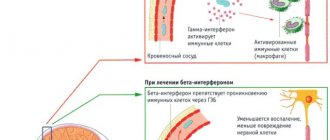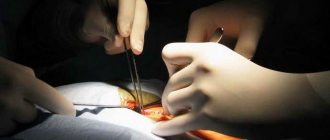Diagnostics
Many diseases, especially at the first stage, are very similar in symptoms and clinical manifestations to multiple sclerosis. Therefore, in order to make an accurate diagnosis, a complex of studies is important. Classical computed tomography, CT agnography, laboratory diagnostics, cerebrospinal fluid puncture, Holter ECG, electroencephalography are of great help in making a diagnosis.
Tomography
The basic diagnostic procedure for detecting multiple sclerosis is tomography.
CT and CT agnography are available at the 5th hospital
CT helps detect large foci of demyelination and a number of other signs that occur in patients with multiple sclerosis.
Huge advantages in using CT agnography:
• The diagnostic method helps to organize the search for narrowings, dilations in the vessels or a complete cessation of blood movement through them. Allows you to create a complete picture of the condition of blood vessels.
• It is a radiological contrast study.
• Good alternative if MRI is contraindicated.
If it is necessary to determine the number and localization of areas of destruction of the myelin sheath of nerve fibers, the world of diagnostics also uses a type of tomography such as MRI.
Laboratory diagnostics
The examination is comprehensive. The following indicators are taken into account:
- Leukocyte formula.
- Glucose.
- Protein.
- Total number of cells.
- Albumen.
- Myelin protein (protein component of myelin).
- Opening pressure
- Oligoclonal IgG groups.
SSEP Study
Somatosensory evoked potentials are tested in some patients. They show how nerve impulses are transmitted to the brain from receptors in the lower and upper extremities. The method aims to look for delays in electrical responses to sensory stimulation.
SSEP is extremely important for diagnosing patients whose lesions are only in the spinal cord, and the brain is not affected by the disease.
Ultrasound of the brachiocephalic arteries (BCA)
A quick opportunity to take full control of the vessels of the neck, which are directly involved in the blood supply to the brain, to assess the degree of atherosclerotic lesions and metallogeny of the course of blood vessels in this area.
An ultrasound scan of the brachiocephalic arteries is very important if multiple sclerosis is accompanied by spinal osteochondrosis and there is a risk of stroke.
The vessels are viewed from different angles. The results of ultrasound diagnostics are a “picture” with the diameter and lumen of the vessels.
Holter ECG
In patients with suspected multiple sclerosis or its development, it is important to study in detail the state of the cardiovascular system as a whole. And you can’t just limit yourself to ECG here. The ideal option is a Holter ECG.
Monitoring is a recording of heart rhythm over a fairly large amount of time: a day or more.
At the same time, the heart rate is recorded in different phases: at rest, during movement, when eating food and, accordingly, chewing and swallowing it.
A solid picture of the rhythm (gastric extrasystoles, pauses), heart rate, and ischemic changes is visible.
Electroencephalography
- Electroencephalography allows you to graphically record the electrical activity of brain cells.
- The procedure is painless and harmless.
- The study is based on recording ultrasonic waves.
- Electroencephalography is effective for analyzing and monitoring brain structures and their displacements. Thanks to these results, the doctor can most accurately determine the degree of development of disorders.
Ophthalmological examination
70% of patients suffering from multiple sclerosis for more than 5 years have optic nerve disorders. Such patients require diagnostics of the structure of the eye disc, computer
computer perimetry to detect the affected area.
The changes in the retina and optic nerve head discovered during the examination are directly related to the level of degenerative lesions in the brain's white matter.
Diagnosis is based on anamnestic and clinical data. At the same time, in order to prescribe the correct treatment, it is important to determine the type of multiple sclerosis:
· Primary progressive. With the progression of the disease, but there are periods with periods of stabilization of the condition.
· Remitting. Two or more exacerbations, between which there is no increase in the severity of the disease. During periods of remission, complete restoration of impaired functions is possible;
· Secondary progressive. The severity of the neurological deficit is constantly and steadily increasing.
It is important to correctly determine the clinical form of the pathology. It can be cerebrospinal, spinal, optical, brainstem, or cerebellar.
Timely diagnosis is the key to choosing the right treatment regimen. But since the picture is often very blurred, it often takes 5 years from the onset of the disease to the diagnosis. This is due to the fact that many diseases are clinically similar. But the more comprehensive the examination, the higher the chance that the diagnosis will initially be made correctly, the patient will be prescribed adequate treatment in a timely manner, and no serious complications will arise.
Doctor, what will happen to me?[edit]
Thanks to advances in alternative medicine science, MS reduces life expectancy by only 5-10 years compared to the rest of the population. However, life will not be sugar, but for whom is it sweet? The disease occurs in both the poor and the rich (NHL hockey player Josh Harding was diagnosed with the condition in 2012, a year later he received a prestigious award and still continues to play), and in the children of celebrities, for example, the son of Ozzy Osbourne. About a third of people with SD live relatively normal lives without significant accumulation of deficits (and without disability) over the course of their lives.
Comparing any other chronicle with the topic of the article, the latter has a fairly large community of users of active people who search for information together and support each other, which is not at all surprising - the debut occurs at the most active age. They almost look like they are pregnant, especially considering that there are more women among the patients, who from time to time are actually pregnant.
Treatment[edit]
The therapy is specific, narrowly targeted and limited to drugs that can be counted on one hand, and then with the same fingers one can point to the sky which option will work. This is the gold standard, a classic (having hundreds of studies and approved by the FDA/EMA) and the only hope, also called “DITs” - drugs that modify the course of MS.
- Interferons:
- beta-1a - Avonex, Rebif, Genfaxon, Synnovex (the latter is recommended by patients to inject terrorists sentenced to death, because it is a low-quality generic; although some are satisfied, the taste and color of all interferons are different);
- beta-1b - Betaferon, Extavia, Ronbetal, Infibeta. First generation, the oldest drugs with a bunch of side effects.
- Chemotherapy (antitumor - it treats lymphomas, leukemia, prostate cancer, breast cancer):
- Mitoxantrone (Novantron, Oncotron). Due to significant side effects, it is used primarily for SPMS, PRMS, and rapid progression of RRMS.
- The most pathogenetic drug that blocks autoimmune reactions:
- Glatyromeracetate (Copaxone) is perhaps the only drug in general that can seriously be called immunomodulatory. It often causes allergic reactions, which is contraindicated for the target group, although the effectiveness of the drug is excellent.
- Antibodies are the last word in treatment, which gives some optimism:
- Natalizumab (Tysabri);
- Fingolimod (Gilenya);
- Daclizumab (Zenapax);
- Ofatumumab (Arzerra);
- Alemtuzumab (Campas);
- Ocrelizumab (Ocrevus)
- Rituximab.
- Steroids:
- in the form of pulse therapy during exacerbation: for example, methylprednisolone (Solu-Medrol);
- or in the form of ACTH analogues (Tetracosactide/Synacthen), which stimulate the synthesis of GCS in the adrenal glands.
All of them are used only by injection, cost a lot of money (compare with interferons and immunomodulators for acute respiratory viral infections - do you think people on DMT suffer from colds less?) and some have unpleasant effects, incl. interferons cause a flu-like condition, which necessitates a whole ritual of drug administration - the “dry needle rule”: after drawing the drug into the syringe, it is necessary to change the needle to a clean one; increase the dosage gradually over weeks; half an hour before the injection, take paracetamol/ibuprofen.
There are also a couple of unclassified drugs that are approved and well used: Teriflunomide (Abagio) - an inhibitor of the mitochondrial enzyme DHO-DG and Dimethyl fumarate (Tecfidera) - somehow an immune system suppressor.
When traveling, people have to carry medicines with them in thermal bags because they need cool storage.
Dietary supplement[edit]
Main article
:
Dietary supplement
Thanks to the unpredictable cyclical nature of the disease (in the case of the most common RRMS), people can be treated for a long time with untested remedies and say, “Here, it’s been 2 years without exacerbations!” I just want to be happy for them, but this never means that the methods used somehow contribute to this.
One can understand patients that they are not very happy with the current state of pharmacology, but it is what it is; Unfortunately, given the small number of drugs, people often find themselves in the tenacious hands of dietary supplement makers who offer a lot of neuroprotectors, antioxidants and other useless pills that only play on trust and hopes. It is worth understanding that this is not at all a disease where you can experiment with treatment, especially with untested drugs.
| I have been in an international company for 3 years, which has been on the market for 15 years. And I take our products - these are dietary supplements. With their help, I improved a lot in my body. But recently I was diagnosed with optic nerve MS, I purchased all the products that are necessary for MS. I only take them and have decided to refuse drug treatment, which the doctor is supposed to prescribe for me tomorrow. I believe that I can cope with this illness. Don’t be afraid of dietary supplements, dietary supplements are great. You just need to find quality ones and know how and when to take them. |
| a typical patient who has found faith in dummies (that’s exactly what you shouldn’t do). |
There are no “proven dietary supplements”: a substance has either been tested, works and is a medicine, or its manufacturer is somewhat obscure, not wanting to register it as a normal drug.
Complications, prognosis
If treatment is not started in a timely manner, or treatment does not take into account the type of multiple sclerosis, the risk of complications is high:
- bursts of causeless, uncontrollable laughter and crying,
- urological infections,
- bedsores,
- tremor,
- epileptic seizures;
- paralysis in the upper and lower limbs,
- trigeminal neuralgia,
- depression,
- diplopia - double vision,
- Lhermitte's symptom is paresthesia (a sudden feeling of intense burning) with a sensation of electric current passing through the back.
Despite the fact that the disease is not simple, for some patients we can confidently voice a favorable prognosis.
If previously, when a diagnosis of “multiple sclerosis” was made, disability began to develop in most patients within 3-5 years, but now, with properly selected medications, it is possible to delay the progression of the disease by 10 and sometimes 20 years.
But much depends on the form of sclerosis. One of the most insidious is the primary progressive form. At first, the symptoms are most vague. The diagnosis is often not made immediately, and treatment, accordingly, is also delayed. But there are often cases when, 10 years after the onset of the disease, the patient simply cannot take care of himself and finds it difficult to move.
At the same time, up to 50% of patients are faced with a form of natural progression. while maintaining the ability to work and practically the usual way of life. The only thing is that they cannot visit baths or stay in the heat for a long time. The main difficulty is to learn to accept your diagnosis and live with it.
Risk factors
Pay attention to the statistics:
- Women suffer from multiple sclerosis more often than men.
- The majority of patients diagnosed with the disease are people aged 18 to 50 years. But you can get multiple sclerosis in early childhood (up to 10% of diagnosed cases occur in childhood) and in adulthood.
- Those who have problems with the endocrine system are at high risk of developing multiple sclerosis. The presence of diabetes mellitus and thyroid pathology is especially dangerous.
- Chronic inflammatory diseases significantly increase the risk.
Excess body weight is also a risk factor. Especially if an overweight person has problems with lipids: in particular, when the content of low-density cholesterol in the blood is increased.
There is a relationship between the disease and a person’s geographic residence:
- Most people with multiple sclerosis live in temperate climates. Here, 1 case is recorded per 300-1000 people.
- In the tropics, one person with multiple sclerosis occurs in a population of 5,000–20,000 people
- Among people who were born and live near the equator, there is the smallest number of cases
Smoking also significantly increases the likelihood of developing multiple sclerosis. This fact has been proven by Norwegian and American scientists. The fact is that smoking saturates the body with neurotoxins.
What is it[edit]
It’s like polyneuropathy, but not as usual in the legs/arms, but affecting the white matter in the head; Everything happens roughly reminiscent of the development of GBS: neurons lose their myelin sheath and nerve impulses begin to be lost, ping increases, the number of lost packets also increases - parts of the nervous system lose communication with each other.
Again, like GBS, this is lupus! autoimmune lesion (the most common one affecting the nervous system) [1]. That’s it, we don’t know anything else, what triggers it, or what provoking factors matter; so, little by little:
- for those living in industrial zones it occurs more often (yup, ecology!);
- viral/bacterial infections (hello, herpes) increase the likelihood;
- as well as injuries, stress, food and everything else.
People get it more often in the northern regions (vitamin D deficiency), although solar radiation is also a risk factor, but this does not equalize the statistics in the south.
It is not even clear whether the autoimmune reactions are primary or secondary, although they are unconditional and clearly expressed in the acute phase of the lesion, but whether the disease begins with them, or whether the whole point is in an unknown previous damage to the myelin is unclear, there is no one to blame yet. There is a certain twist about genetics, since the disease does not seem to be considered hereditary, but familial cases make up up to 10% percent, and some nations are more susceptible to it than others. [2]
In general, the coolest and most succinct description of the development of MS is expressed in one phrase: “the occurrence of this disease is associated with a random individual combination of unfavorable endogenous and exogenous risk factors”
. Wow, wow. You can't hide, everyone has a chance. All this and something else unknown leads to the formation of an inflammatory plaque, where myelin destruction, demyelination, occurs.
Occurs between 20 and 50 years, twice as often in women. [3]
McDonald[edit]
The most recent criteria for making a diagnosis named after MacDonald from 2010; the first two do not need additional data:
- two or more exacerbations + two or more lesions on imaging;
- two or more exacerbations + one or more lesions, but there is strong evidence of anamnestic data.
If there is only one exacerbation, or progression of symptoms without exacerbations, or if there is only one focus, one should look for distribution in time/space using MRA or waiting for the appearance of new exacerbations/foci.
MRI is the main method of objectively confirming the diagnosis, allowing you to see “black holes” in the head on T1 mode, or, conversely, bright spots on T2. Gadolinium contrast allows you to see even small lesions, but in general the main purpose of contrast is to determine the activity of the process and separate plaques into old and new.
Lumbar puncture most often becomes the icing on the cake of a completed diagnosis.
EDSS[edit]
Expanded Disability Status Scale - a rating by which patients are measured against each other on the topic of who is more or more ill. The interesting thing is that movement on the scale is not always inexorable-only forward; often people roll back to the recovery point with a lower score. The rating is of interest not only to doctors and their clients, but also to ordinary people, since it allows them to feel the frailty of life.
The assessment is made based on the number of affected functional systems and clinical manifestations:
- Sensitivity;
- Pyramid - walking;
- Cerebellum - coordination;
- Urinary and bowel control;
- Visual - vision;
- Brainstem - speech and swallowing;
- Mental;
- Other - any other neurological problems of MS, for example, fatigue.
The last two points are almost not taken into account, for which the scale is criticized - the same depression, like a violation of mental function, happens quite often and quite reduces activity, but is ignored by the point system.
0.0: Start: everything is fine. 1.0: Not disabled, but you can find a neurological deficit in one function (reduced vibration sensitivity, for example). 1.5: Still not disabled, but deficit affects more than one function. 2.0: Slightly disabled in one of the functions (constantly staggers a little when walking). 2.5: Slightly disabled in one function or slightly disabled in two. 3.0: Almost disabled by one, or slightly disabled by 3-4 (still ambulatory). 3.5: Almost one at a time + a little at 1-2; or almost two; or a little bit of five. 4.0: Already disabled, but ambulatory and satisfactory: he walks almost all day on his own, can pick up and walk half a kilometer without assistance/rest. 4.5: Same, can work with some restrictions/assistance and walk 300 meters without rest. 5.0: Forced march reduced to 200 meters, performance reserves require part-time work. 5.5: Hundred meters like Usain, only not fast and on foot, but without help. Full-fledged household activity is not excluded. 6.0: 100 meters with a stick only. 6.5: Cane/crutches/walker needed to cover 20 meters. 7.0: Movement damage radius is limited to five meters; When you have a “wheelchair” device, movement and activity are limited only by the lack of ramps. 7.5: A few steps at most, then only wheels with a motor as an assistant. 8.0: More immobile than movable and spends most of the time in bed/chair, but can care for himself. 8.5: Same, self-service is difficult. 9.0: Only bed, but can send you away to chat and eat. 9.5: Complete disability without communication and food, because he cannot swallow. 10.0: Finish and sad credits (no one knows the practical value of this point).
What is the problem?
Multiple sclerosis is a progressive disease in which the integrity of the membranes of nerve cells is compromised. The lesions are located in the brain and spinal cord. The occurrence of multiple sclerosis is associated with the pathological process of damage by the body to its own tissues. This occurs when the body's defense system mistakenly perceives its own normal cells as pathogenic. Such an error can occur, for example, after a viral or bacterial infection, if the surface receptors of viruses and bacteria have a similar structure to the receptors of normal cells of the body. Immune cells encounter these receptors and launch a full-scale “military campaign” against their carriers, destroying both “strangers” and “friends.” This reaction is called autoimmune, and it can develop, in addition to the nervous system, in almost any organ and tissue.
Article on the topic Not only Hawking. What is ALS and how do Russians live with a rare disease? Multiple sclerosis, by the way, is not the only autoimmune disease of the central nervous system, but it is the most common and one of the most dangerous. It is not for nothing that it was included in the state program “7 nosologies” as having great social significance. It is important to recognize multiple sclerosis as early as possible by the first symptoms. After all, the sooner treatment begins, the less the nervous system will be damaged by immune inflammation, and the person will retain his capacity.
Early diagnosis of multiple sclerosis is, it must be said, not an easy task even for an experienced doctor. But, armed with knowledge about the most common symptoms of this disease, you can independently suspect its presence, which will do a great service to the sick person.
It is also important to talk about why multiple sclerosis is called that way. The fact is that during histological examination of nervous tissue damaged by multiple sclerosis, plaques of various sizes (Latin sclerosis) are found scattered (or scattered) in the tissues of the brain and spinal cord. Also, these plaques appear at different times, so you can find both “old” and “fresh” variants. So, multiple sclerosis is a multifocal autoimmune lesion of the central nervous system, dispersed in space and time, which is one of the defining characteristics of this disease.









